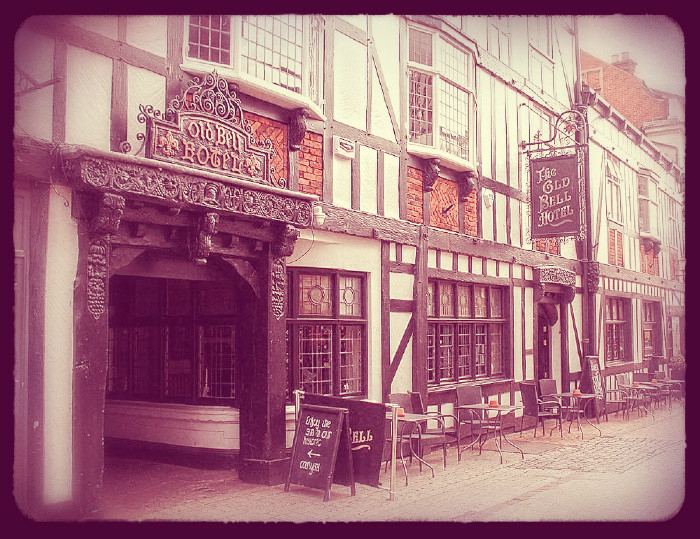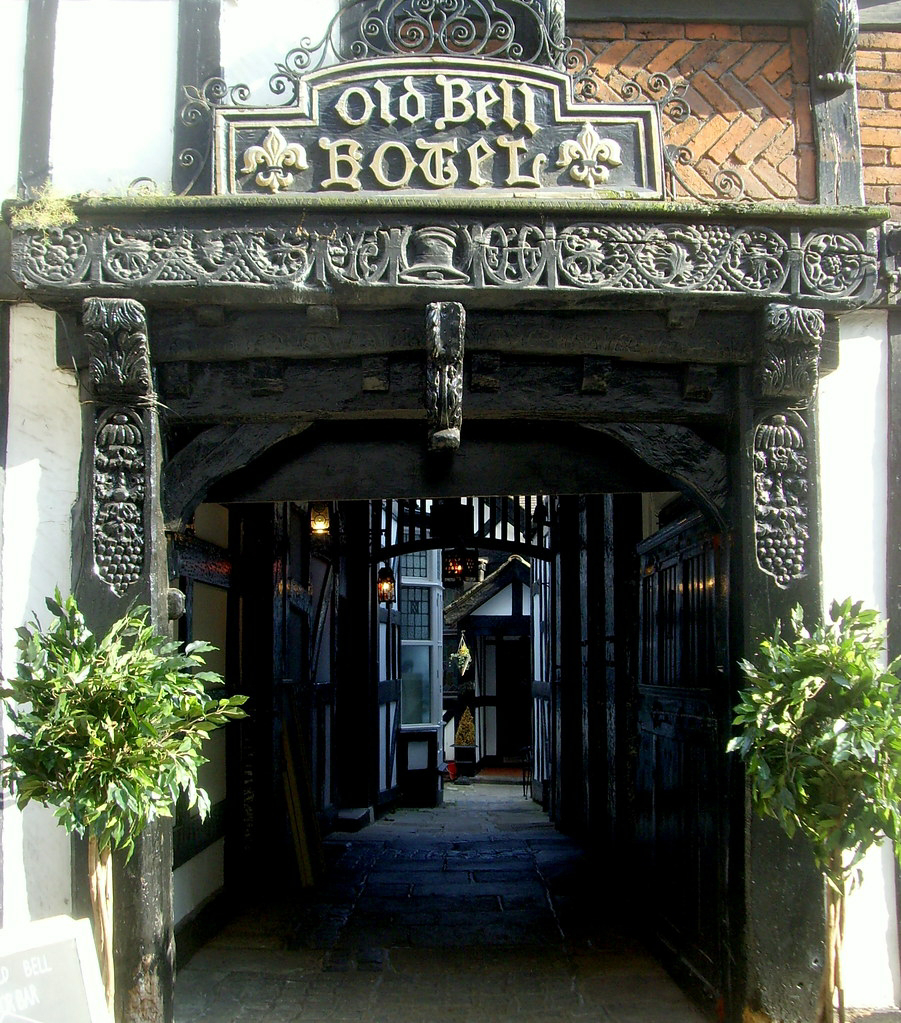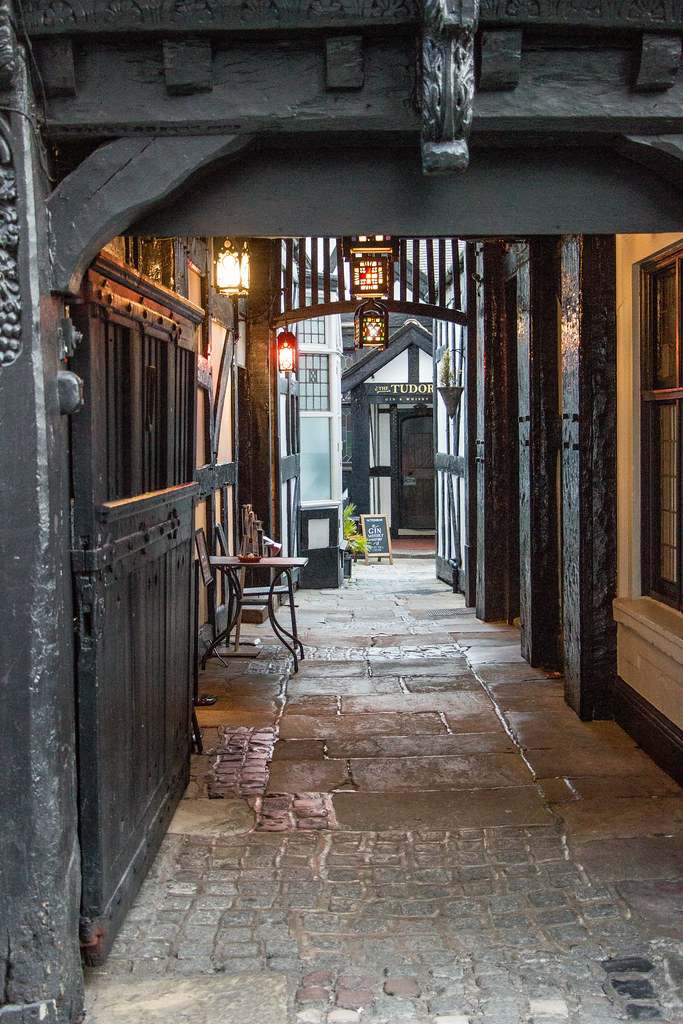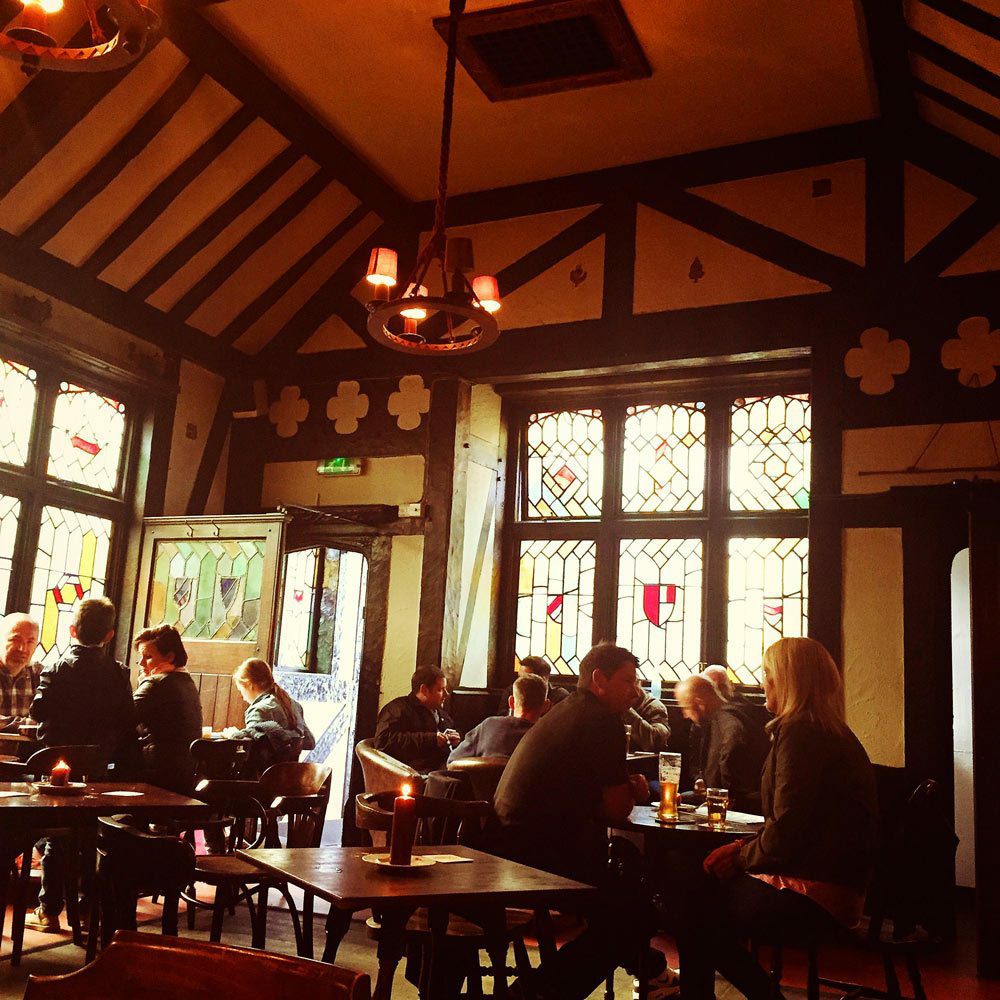The Old Bell Hotel
The Old Bell Hotel is located within the Cathedral Quarter on Sadler Gate in Derby, England. The location is said to be over 350 years old, and so is Derby's largest and last surviving coaching inn. The location has played host to a number of famous individuals from Bonnie Prince Charlie to Paul McCartney. Having once been a prestigious coaching inn, the location fell to disrepair over the years and closed to the public in 2012. What has been called 'the largest renovation project in history' has since occured, costing a total of £1.3 million, and as a result the Old Bell Hotel is open once more. With such a long history, it is expected for a number of hauntings to be present, and there are a few stories about the haunted happenings here. Two hauntings are thought to revolve around maids who have died within the hotel, and it's said that there is a malevolent soldier present too.
History
There are two discussed dates for the year The Old Bell Hotel was constructed. It was originally known as The Bell Inn, and some call it The Old Bell Inn. The most common cited date for the building's construction is 1650, however some sources have said the location was built in 1680 by the Meynells; a family which belonged to the Derby gentry of the time. Regardless of the year of the building's construction, at the time it was one of the most prestigious coaching inns outside of London, and had its own stables and livery. Throughout the 1600s and 1700s, the building was the centre for travel, food, hospitality, and leasure in Derby. It was also home to many families over the years.
During the inn's peak, it contained up to fifty guest rooms and featured seven on-site bars, along with restaurants. The building also had its own dog kennels, which can still be seen today, where animals belonging to stagecoach drivers and high profile visitors would be kept. These cages were 5ft in size. One such high profile visitor was Bonnie Prince Charlie who used the location as a billet during the 1745 Jacobite Rebellion before marching with his troops down to London. The Jacobean stairs in The Old Bell Hotel are the same as what Charlie and his army would have used during this time. The original service bells and mechanisms can also be seen beside these stairs with some original room numbers. This staircase is one of few Jacobean staircases left in Derby and goes to the top of the building towards the attic rooms.
Shortly after, in 1776, the building was extended to feature a grand ballroom. This addition reflected the locations status in high society, and at one point in time it was split to be three seperate rooms. The largest of these three rooms was the Regency Room, which had its own bar and lounge. Where the ballroom is located was once the site of some of the fify rooms, but these rooms were knocked down to make way for the extension. Currently, the ballroom is known as the Grand Regency Ballroom. One inconsistency I've found with the ballroom is that apparently afternoon concerts occured in this space during 1775, so it's possible that it opened late 1775 with some sources citing 1776 as a result.
The alley into the courtyard was the main entrance for travellers and stagecoaches, and was lit with gas lanterns which have since been modernised and can still be seen today. Another alleyway was located to the right of the building which led to the back of the building, and this was used by stagecoaches which were leaving the inn. It also provided easy access to the stables and kennels. The stables events space is currently where that alley used to be, but the old arches that stand in the centre and remain part of the structure can still be seen.
There was once a row of cottages where the courtyard is, but this changed when the Tudor Bar was built. Some of the fifty guest rooms were also located in the courtyard area. Currently the courtyard contains the original water pump, and the original stable master's quarters can be seen at the bottom of the courtyard. As this space was where stagecoaches arrived, it likely would have been one of the most physically active areas of the location during this time period.
During 1780, the Bell Inn was aquired by John Campion; and it was during this ownership that Joseph Masters worked washing horses in the stables. Masters was born in 1802, and was employed at The Bell Inn possibly around 1809/1810. After leaving the inn, Masters went on to become one of the original Bow Street officers. The Bow Street Runners, as these officers were known, were London's first professional police force. Masters also went on to become a figure in the early settlement of Wairarapa in New Zealand, and established both Greytown and Masterton there in 1854.
During 1839, the railway came to Derby and following this event, some more of the fifty rooms at the inn were knocked down. Within 1842, floods occured in Derby, and it's said that the nine year old grandson of John Campion II was 'launched in a washtub in the cellers' to retrieve some vintage bottles of wine. On the 13th of May 1884, the inn played a part in the history of the Derby County football club as it was on this day that the club were christened as a new football club during a meeting at the inn. A year later, during 1885, the final coach left the inn and the location ceased in its role as a coaching inn. As a result, the building became a hotel and the Tudor-style front was added in 1929 by Ford and Weston. The attic rooms are currently the last hotel rooms left in the building, and they still exist with their original room numbers.
Some sources have said the building has also been used as a mail house, a courtroom, a jail, and a doctors surgery over the years; however I've found no clear evidence of this amongst sources. Apparently the cellars were used as prison cells, and there is a network of pathways and tunnels which link the building to other parts of the city. I feel the sources who have cited the location as being used for other purposes have commented on an unofficial use I've found which came about due to the established visitors of the inn.
The Tudor Bar was visited by the likes of judges, police officers, and councillors; and there is a story about one group of drinkers discussing if a man should hang or be sent to prison. The story says they finished their drinks and decided the man should hang, something which could be interpreted as the Tudor Bar being used as an unofficial courtroom of sorts. It was one of the most exclusive bars in Derby during the early 1900s, and was a gentleman's only bar. Many significant people in Derby's history visited the Tudor Bar, and discussions were also held here about bringing the railways to Derby. It also had only one toilet as only men were allowed in. Today this toilet is unisex.
One significant individual connected to The Tudor Bar is the head barmaid Alice. She was the only woman allowed in this bar and was known for being both strict and stern. She often gave men a telling off for poor behaviour or for disrespecting the bar. Through this temperament, Alice earned the respect of visitors and she worked in the bar long after she retired. A painting featuring Alice currently hangs on a wall in the bar.
The two other bars which exist today are The Belfry Bar and The Tavern Bar. The Tudor Bar has been restored with over £55,000 being spent on the renovation so that it now looks almost identical to how it did back in the early 1900s. The Tudor Bar features an original grand fireplace which uses reclaimed materials that date back to the time of the buildings construction. The stags head, rifles above the bar, and stained glass windows were all replaced or copied during the renovation. Before the renovation, the bar had fallen into the cellars, the roof was patchy with rain entering, and the tudor-style panelling was in need of repair. A coffin was discovered beneath the bar, and apparently it's still there today. The Tavern Bar features the original hotel room bells which hang above the bar along with other original features. The Befry Bar was once the place to find local footballers, but closed during the 1980s until it reopened as part of the Belfry Steakhouse restaurant.
During 1969, the hotel became a nightclub which lasted until the 1980s. Famous faces such as Paul McCartney and John Lennon visited the hotel, but that didn't save it from being left unoccupied from the early 2000s. It finally closed in 2012 due to neglected maintenance and poor management, and had its license suspended in the April of 2012. This was due to an attack which resulted in the death of the twenty-four year old Ashley Finley on the street outside of The Old Bell Hotel. Also during 2012, a local businessman called Paul Hurst bought the building. When he bought it, the ceiling domes were boarded up, it was inhabited by squatters, plus there was damage from rats, pigeons, and woodworm. There was also a buddleia which was growing from the front of the building that had caused £100,000 worth of damage. It cost £30,000 for each boarded up dome to be restored, and the building was high on a list of Derbyshire's buildings at risk, plus there was a high threat of arson.
Paul spent two or three years and £1.3 million renovating The Old Bell Hotel. Renovations began either in 2013 or 2014, and Paul worked with both Derby City Council and English Heritage to restore the building. This change of ownership allowed for a rescue scheme to be implemented and so various grants were obtained and personal funding was provided towards the restoration. Since reopening, the location has won various heritage awards and hosts the award winning Faulty Towers dining experience. Footfall on Sadler Gate has increased too and the reopening also resulted in a 100% occupancy rate of shops on that street. Originally the street was named after the trade of that street being mostly saddles, Iron works, and blacksmiths; but now the street is filled with independent shops and bars. The reopening of The Old Bell Hotel resulted in the Cathedral Quarter gaining the City High Street Award of 2016, and The Old Bell Hotel also offers two hour long ghost tours.
Hauntings
Most of the reported hauntings stem from tales about maids who worked at the inn. One of these maids is thought to be Mabel, a linen maid who washed and changed the bedsheets while the location was a coaching inn. Her lover was taken away to war and killed, and so upon hearing this news and finding out she was pregnant with his child; Mabel hung herself in room 29. I have also read that this room was room 6, but it seems the general consensus is that it was room 29 in the attic.
The other maid spirit is thought to have been murdered by Jacobites during 1745, and it's said she wears clothes from the 1700s which includes a white cap. It's thought she haunts one of the upstairs rooms. This servant girl is thought to appear when children are present, and there are two recorded instances of this happening. During the 1930s, the landlords son suffered from asthma, and one night the landlord heard his son coughing and choking in his bedroom. The landlord ran upstairs and when he entered his sons room, he saw a lady dressed in clothing from the 1700s bending his son over and patting him on the back. As the dad took over, the lady vanished.
The second account is from the 1950s, and occurs in the same room. The room had been converted into a nursery by this time. The landlady was was changing her baby, turned away to grab nappy pins and cotton, and when she turned back she saw the figure dressed in 1700s clothing. The figure was standing over the baby and stooping as thought to pick up the child. The landlady rushed to pick up the child, and when she did the figure disappeared. Apparently guests have also reported that their clothes have been folded and placed at the bottom of their bed, despite no one having entered their room to do so.
The soldier who killed this second maid is also thought to haunt the building, and that he is located on the top floor. Apprently investigators have commented on his description and on how evil he is. A woman inna blue victorian style dress is also reported to be in this location and she is said to appear in one of the downstairs bars. There is also a poltergeist who throws things when distressed. Coat hangers have been thrown, and a waitress has experienced activity in a bar on the first floor. She was setting the tables, left for a moment, and returned to find everything on the tables had moved to be in a different order. There are now two ways in and out of that room, but records show that there was only one way in and out when this was reported. The waitress was sure that no one had entered the room as they would have passed her and she saw no one do so.
Its been reported that an article from Derby Mercury featured a tale about a man called Walter Walters who is said to have died within the inn. Walter stayed there for several weeks before the landlord asked for the bill to be paid, and Walter refused by saying 'you won't get a penny from me, nor will anyone'. Walter then went to his room and didn't emerge for breakfast the next morning. Wondering where Walter was, the landlord went to check on him and found his body with his throat cut from ear to ear. It wasn't sure how Walter died, and people have questioned if it was murder or suicide. The room Walter died in is now the accounts office and the team experience strange sensations in there.
Summary Of Hauntings
1. Mabel, maid, hung herself in room 29/room 6 - room 29/room 6/attic
2. Murdered maid, 1700s attire, white cap, appears before children
3. Soldier, 'evil' - top floor
4. Walter Walters (?), murdered in what is now accounts office - accounts office
5. Clothes folded untouched
6. Coat hangers thrown
7. Poltergeist, throws things when distressed
8. Woman, blue victorian dress - one of the downstairs bars
9. Strange sensations - accounts office
My Thoughts
This is another weird one to me. It's odd how some old places, especially inns, can have so many hauntings but then you'll get ones like this and they have barely anything. It's also said that Derby is the haunting capital of England, so by that reputation you'd expect The Old Bell Hotel to be brimming with ghosts. Instead, there are two maids who might actually be the same maid, a soldier, a poltergeist, and a victorian woman that no one knows anything about. It's strange too because the stories about Mabel and Walter aren't tied in with any ghosts, at least not directly. It's purely imagination and speculation which suggest that these two people are potential candidates for haunting activity. No sources have said the ghosts are that of Mabel or Walter, and that's interesting to me.
It seems like there is lots of talk about what is supposed to be there, or of what is expected to be there, rather than definitive talks about what is there for certain. This could be due to the location not being investigated often, and it could also be to do with the renovations and disrepair the building fell into. I have to say the most interesting point to me about the hauntings here is the detail regarding the maid interacting with children. Both stories are similar, but the one with the baby has a striking difference, and that difference is the fear involved with the mum. When the dad saw the maid with his son, the dad took over in a seemingly calm way, but the mum with the baby grabbed the baby before the maid could. This indicates to me that the interaction with the baby was more sinister in nature, although it could be argued that a mum is more protective of their baby than a dad is of his son.
I know there are stories about fairies and spirits stealing children and babies, and this is why I find that encounter with the baby particularly interesting. I don't think there is truth to that, but the parallel is of great intrigue. It's also interesting as Mabel was pregnant when killing herself, so perhaps the care displayed for children is some sort of regret being shown by Mabel. It definitely provides good food for thought; something I wasn't expecting from a location with so few details on hauntings.
Thank You!
Thank you for reading to the end of this article! I'm quite glad to have finished this one as it's the last I'll be talking about Derby for a bit of time. The next location article will be about somewhere in Manchester, another city said to be incredibly haunted, so I'm expecting a good bit of history and a fair few hauntings from that article. I could be wrong, but that's the impression I'm getting so far.
A special thank you goes to Damain, Nicolette, Kerry, GD, Chris Willcx, Nicola Jada, Nita Raveling-Hamilton, The Cornish Ghost Whisperers, Beardo Gets Scared, Starlight Phoenix Paranormal, Paranormal Penny Pinchers, the Australian Paranormal Society, Codegas Codex of Curiousity, Phantom Detectives LLC, Shadow Walkers Paranormal Investigators, South Of Spooky, and Don't Scare Claire for your continued support of The True Paranormal. If you want to be thanked in an article, then please share this article across social media and tag 'The True Paranormal'. If I see that you've shared, then I will thank you in the following article.
If you want to follow The True Paranormal you can do so on Facebook, Tik Tok, Instagram, X (formerly known as Twitter), and Tumblr. You can also subscribe to The True Paranormal on YouTube, or directly to this website through the bar on the left which will give you email notifications. That bar also lists all of the links which will take you to The True Paranormal's various social media platforms. If you want to contact me about your own experiences, or about anything at all paranormal, you can email thetrueparanormal1@gmail.com
A Donations Message
At the moment I don't have any ads running on anything, and I intend on the blog always being free for everyone to view because I believe knowledge should never be kept behind a paywall. I do, however, still need an income in order to continue writing articles. If you would like to donate towards The True Paranormal, you can do so via PayPal. If you are interested, my username is Daniel Carr and my paypal email is danielcarr130913@gmail.com. If you donate, I will be sure to thank you across social media and in my articles. Anything donated is much appreciated.
Sources I Have Used
11. Derby Telegraph
12. Christie & Co
14. What Pub
16. Flickr
17. Flickr: Hotel
20. Love Derby
22. Discover Derby
24. Twisted Tree
25. Derby World
26. Haunted Rooms
28. Flickr: Old Bell
32. Sublime Stays













Comments
Post a Comment